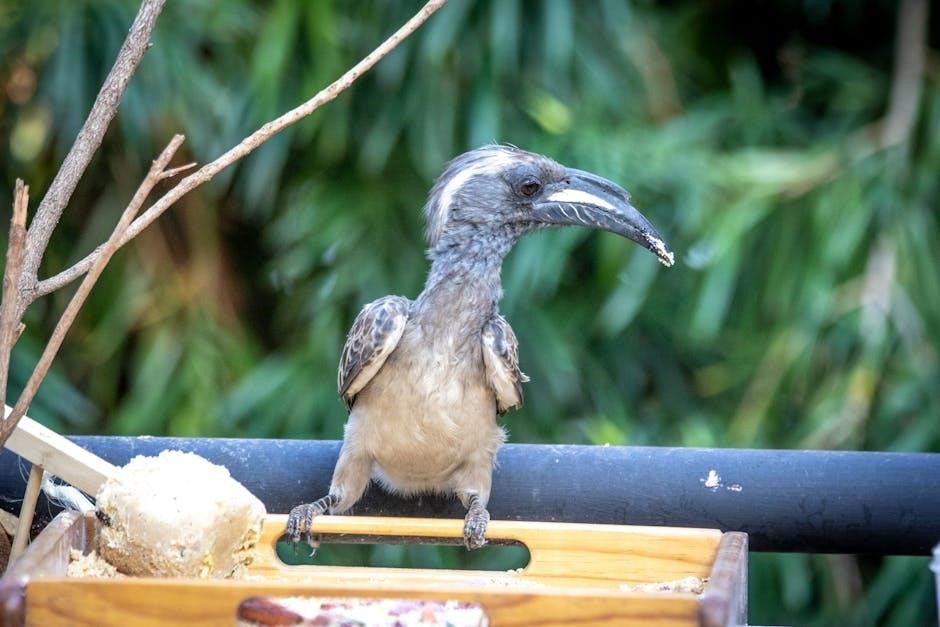Bird feeder plans PDFs provide step-by-step guides for creating bird feeders, including materials, designs, and assembly instructions. Perfect for DIY enthusiasts, these plans offer easy-to-follow blueprints for crafting functional and attractive feeders to attract birds to your yard. Many plans are available for free, catering to both beginners and experienced builders.
Overview of Bird Feeder Plans
Bird feeder plans PDFs offer a wide variety of designs, from simple to complex, catering to different skill levels and preferences. These plans typically include detailed diagrams, material lists, and step-by-step instructions for building feeders. Whether you prefer hanging, platform, or recycled material feeders, PDF guides provide clear blueprints. Many plans emphasize ease of assembly and customization, allowing users to tailor designs to their needs. They often feature budget-friendly options, such as using cedar wood or repurposed materials, making DIY bird feeders accessible to everyone.
Why Use Bird Feeder Plans?
Bird feeder plans PDFs simplify the process of creating bird feeders by providing clear, structured guides. They help users save time and money by offering precise material lists and step-by-step instructions. These plans cater to various skill levels, making DIY projects accessible to everyone. Using bird feeder plans ensures that your feeder is functional, durable, and visually appealing. Additionally, they allow for customization, enabling you to tailor designs to attract specific bird species or match your yard’s aesthetic. This makes building a bird feeder an enjoyable and rewarding experience for nature enthusiasts and DIY lovers alike.
Benefits of DIY Bird Feeders
DIY bird feeders offer numerous benefits, including cost-effectiveness and the ability to customize designs to suit your yard and attract specific bird species. Building your own feeder fosters a sense of accomplishment and connects you with nature. It also allows you to use recycled materials, promoting sustainability. Additionally, DIY projects can be a fun family activity, teaching children about wildlife conservation. With bird feeder plans PDFs, you can create a feeder that fits your budget and skill level, ensuring a rewarding experience for both beginners and experienced crafters.
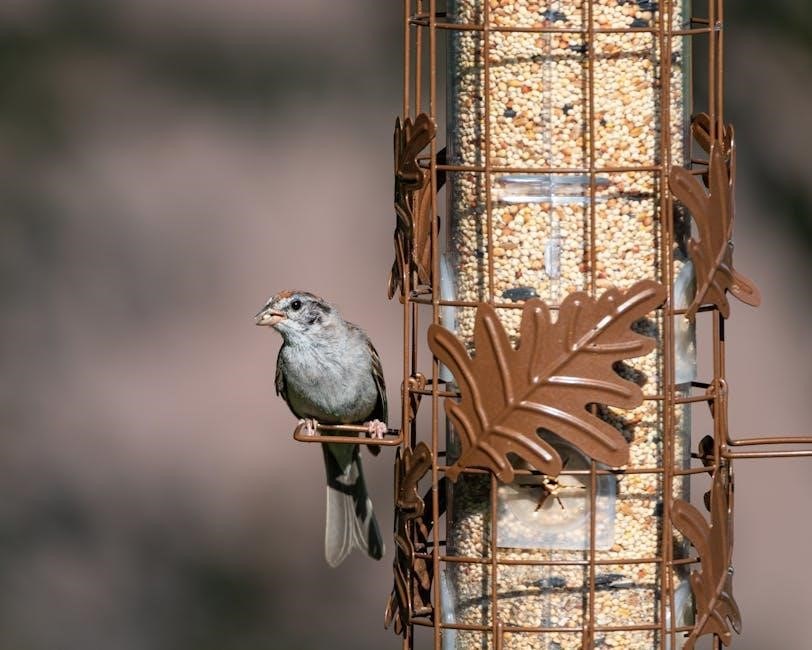
Types of Bird Feeders
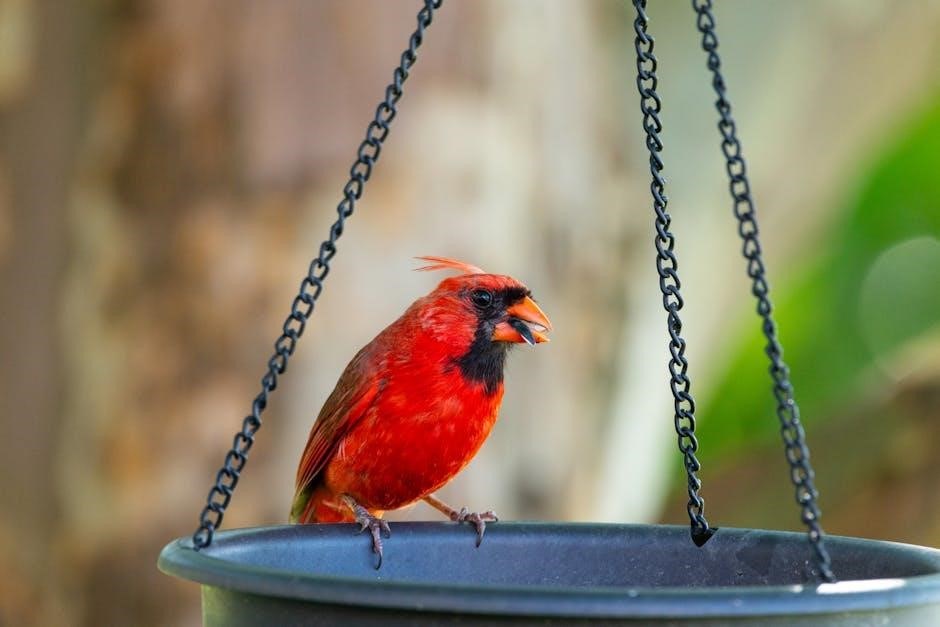
Types of Bird Feeder Plans
Bird feeder plans include hanging, platform, wooden, and recycled material designs. These styles cater to different bird species, offering versatility for backyard birdwatching enthusiasts.
Hanging Bird Feeders
Hanging bird feeders are a popular choice for their ease of installation and versatility. They can be made from various materials, including plastic, metal, or wood, and often feature simple designs. Many DIY plans include instructions for crafting hanging feeders using recycled items like plastic bottles or cardboard tubes. These feeders are ideal for small spaces and can be suspended from trees or porches. They attract a variety of bird species and are easy to refill and clean. Some designs include perches or trays for added convenience.
Wooden Bird Feeders
Wooden bird feeders are a classic and durable option, offering a natural aesthetic that blends seamlessly into outdoor settings. Many bird feeder plans PDFs include designs for wooden feeders, often using cedar or pine for their weather-resistant properties. These plans typically provide detailed material lists, such as wood planks, screws, and hinges, along with step-by-step instructions for assembly. Wooden feeders can be customized with paint or stains to match your yard’s style. They are also easy to maintain and can be designed to attract specific bird species, making them a popular choice for backyard birding enthusiasts.
Recycled Material Bird Feeders
Recycled material bird feeders are an eco-friendly and creative way to provide birds with food while reducing waste. Plans often use items like plastic bottles, milk cartons, or mason jars. These designs are simple, requiring minimal tools and materials. For example, a 2-liter bottle can be transformed into a hanging feeder by cutting holes for seed access and attaching a perch. Recycled feeders are budget-friendly, teach kids about sustainability, and attract birds effectively. They also offer a fun DIY project for families or classrooms, promoting environmental awareness and bird-friendly habitats.
Platform Bird Feeders
Platform bird feeders, also known as tray feeders, are flat, open designs that allow birds to feed easily. They typically consist of a shallow tray with a rim to hold seeds. These feeders are often placed on the ground or low to the ground, making them accessible to birds that prefer feeding at lower levels. Platform feeders are simple to construct and clean, using materials like wood or recycled plastic. They attract a variety of bird species and are ideal for areas with limited space. Their open design makes them easy to refill and maintain, ensuring consistent feeding for birds.
Materials Needed for Bird Feeders
Bird feeder plans require materials like wood, plastic, or PVC. Essential items include screws, nails, glue, and waterproof sealant. Ropes or chains are needed for hanging, along with trays and optional features like roofs or perches.
General Materials List
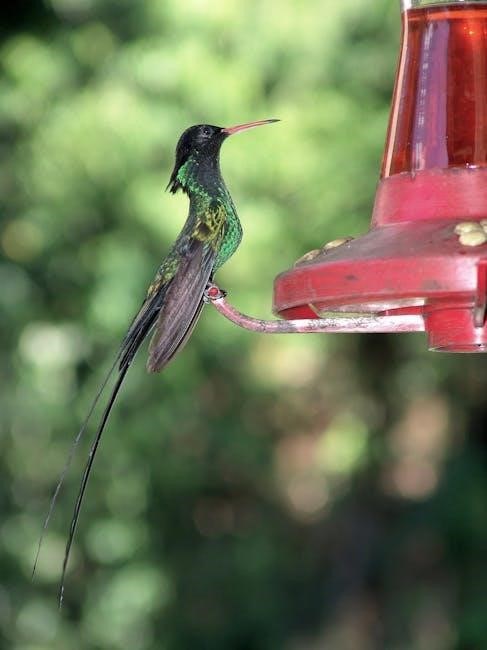
A general materials list for bird feeders includes wood (cedar or pine), plastic, or recycled materials. Essential hardware comprises screws, nails, and waterproof glue. Plastic or metal tubes, trays, and perches are also needed. Ropes or chains are required for hanging, while optional features like roofs or adjustable feeding ports may be added. Waterproof sealants ensure durability, and paint or stains can enhance the design. Detailed lists vary by plan, but these basics provide a solid foundation for most DIY bird feeder projects.
Cedar Wood for Bird Feeders
Cedar wood is a popular choice for bird feeders due to its natural durability and resistance to rot and insects. It is lightweight, easy to work with, and emits a pleasant aroma that can help deter pests. Cedar blends seamlessly into outdoor environments, making it an aesthetically pleasing option. Many bird feeder plans recommend using cedar for its longevity and low maintenance. Additionally, it can be stained or sealed for extra protection, ensuring your feeder withstands various weather conditions while remaining an attractive addition to your yard.
Tools Required
Building a bird feeder typically requires basic woodworking tools, such as a drill, hammer, saw, and screwdriver. A tape measure ensures accurate cuts, while a utility knife is handy for smaller adjustments. Sandpaper may be needed to smooth rough edges. Optional tools include a jigsaw for curved cuts or a paintbrush for finishing. These tools are essential for assembling and customizing your bird feeder, ensuring a sturdy and visually appealing design. Proper tools make the construction process efficient and enjoyable.
Optional Features
Optional features for bird feeders include squirrel-proof mechanisms, adjustable trays, roof extensions, and built-in perches. These enhancements improve functionality and attract more birds. Squirrel-proof designs use weight-activated perches or cages to prevent unwanted visitors. Roofs protect seed from rain, ensuring dryness. Trays catch spills, reducing waste. Perches provide comfortable landing spots for birds. Customization options, like paint or decorative themes, add personal touches. These features allow you to tailor your feeder to specific needs, enhancing both performance and visual appeal for a more enjoyable bird-watching experience.
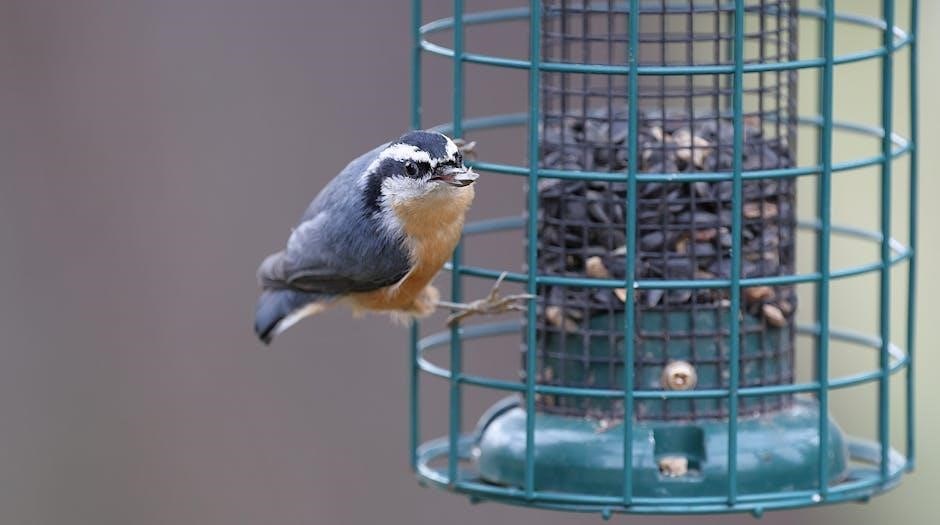
Assembly Steps
Assembly steps involve preparing materials, constructing the feeder, attaching perches, and adding trays. Follow plans for precise instructions to ensure stability and functionality of the bird feeder.
Preparing the Materials
Preparing materials is the first step in building a bird feeder. Gather all components, such as wood, screws, and nails, ensuring they match your PDF plan specifications. Sand wooden pieces to smooth edges and surfaces. Measure and cut materials according to the plan’s dimensions. Sort hardware like hinges and hooks to streamline assembly. If using recycled materials, clean and disinfect them before use. Organize tools, such as drills and saws, within easy reach. Preparing materials correctly saves time and ensures a smooth assembly process for your bird feeder.
Assembling the Feeder
Assembling the bird feeder involves following the PDF plan’s instructions to bring all components together. Start by attaching the sides and base using screws or nails, ensuring a sturdy structure. Install the roof or lid, securing it with hinges for easy refilling. Attach perches and feeding trays according to the design. Use waterproof glue or sealants to protect against moisture. Ensure all edges are smooth and safe for birds. Follow the plan’s assembly sequence carefully to maintain balance and functionality. This step transforms prepared materials into a functional feeder.
Adding Perches and Trays
Adding perches and trays enhances the functionality of your bird feeder. Cut small holes in the feeder’s base for the perches and attach them using screws or nails. Ensure perches are the right size for birds to land comfortably. Trays can be added below to catch spilled seeds, reducing waste. Use waterproof glue to secure trays and perches, ensuring durability. Some plans include optional features like adjustable trays or seed catchers. Proper alignment and sturdy attachment are crucial for the feeder’s stability and bird safety. Follow the PDF guide for precise measurements and placement. This step ensures birds can feed effortlessly and comfortably.
Final Touches
After assembling the feeder, apply a waterproof finish like varnish to protect it from the elements. Allow it to dry completely before filling with seeds. Ensure all edges are smooth and safe for birds. Install any optional features, such as roof extensions or drainage systems, according to your plan. Hang the feeder in a shaded area to protect seeds from direct sunlight. Double-check all parts for stability and security. Finally, clean the feeder thoroughly before placing it outdoors to welcome your feathered friends. Proper finishing ensures durability and safety for the birds.
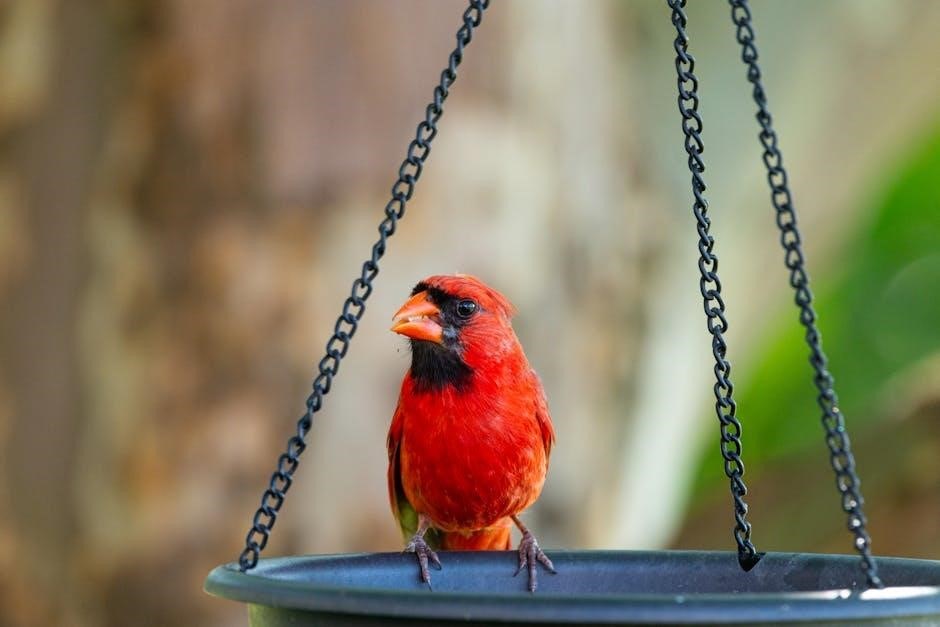
Installation and Placement
Position bird feeders in shaded areas to protect seeds from direct sunlight. Ensure the feeder is at least 3 feet above the ground to prevent predator access. Place it near trees or shrubs for birds to perch and feed safely. Avoid areas with strong winds to maintain stability. Proper installation ensures optimal performance and bird safety, enhancing the overall feeding experience for your feathered visitors while maintaining ease of maintenance.
Choosing the Right Location
Position your bird feeder in a shaded area to protect seeds from direct sunlight and prolong freshness. Ensure it’s near branches or shrubs for birds to perch comfortably while feeding. Avoid placing it in strong winds to prevent swaying and seed spillage. Choose a spot with good visibility to enjoy birdwatching and ensure ease of maintenance. The feeder should be at least 3 feet above the ground to deter predators and pests. Proper placement enhances bird safety and feeding efficiency, making your yard a welcoming habitat for birds.
Hanging the Feeder
To hang your bird feeder, choose a sturdy tree branch at least 3 feet off the ground to deter pests. Use durable twine, rope, or a metal hook to secure it. Ensure the feeder is level and balanced for even seed distribution. Place it near branches for birds to perch but far enough to avoid collisions. Avoid overhanging obstacles to reduce spillage. Regularly inspect the hanging mechanism for wear and tear, ensuring it remains stable and secure. Proper hanging ensures both bird safety and feeder longevity.
Maintenance Tips
Regularly clean your bird feeder to prevent mold and bacterial growth. Remove the roof or top section, rinse with a mild vinegar solution, and dry thoroughly before refilling. Check seed levels weekly to ensure they remain plentiful. Trim nearby plants to maintain visibility and accessibility for birds. Inspect the feeder for damage or wear, repairing any holes or loose parts promptly. Clean perches and trays to keep them free from debris. Regular maintenance ensures the feeder remains functional and attracts birds consistently while keeping them healthy and safe.
Advanced Bird Feeder Options
Explore advanced bird feeder options for enhanced functionality and design. Consider automatic dispensers, custom shapes, and innovative materials. For example, Brome’s squirrel-proof design offers superior durability and efficiency.
Customizing Your Bird Feeder
Customizing your bird feeder allows you to tailor its design to your preferences and yard style. Use materials like cedar wood or recycled items for a unique look. Add features such as adjustable perches, seed trays, or roof designs to enhance functionality. Personalize with paint or decorative elements to match your garden decor. Advanced plans often include options for intricate details, ensuring your feeder stands out. This creative freedom makes DIY projects rewarding and adaptable to any bird-watching setup.
Large-Scale Bird Feeders
Large-scale bird feeders are ideal for attracting multiple bird species and accommodating ample seed quantities. These feeders often feature elaborate designs with multiple compartments or trays, ensuring efficient feeding. Constructed from durable materials like cedar wood or metal, they are built to withstand weather conditions and heavy use. Plans for large-scale feeders typically include detailed instructions for assembly and optional features like roof extensions or dividers. These feeders are perfect for backyard bird enthusiasts who want to create a welcoming habitat for various bird types. They can also serve as a decorative focal point in your yard.
Automatic Bird Feeders
Automatic bird feeders offer a convenient and efficient way to feed birds without frequent refills. These feeders often feature timers or sensors that dispense seed at set intervals, ensuring a steady food supply. Designs vary, with some using digital controls and others relying on gravity-fed mechanisms. They are ideal for busy individuals or those who want to maintain consistent feeding schedules. Many plans include optional features like weight-activated perches to deter larger birds or squirrels. With proper installation and maintenance, automatic feeders can enhance your bird-watching experience while minimizing manual effort.
Safety and Bird-Friendly Features
Bird feeders with smooth surfaces and weight-activated perches deter predators while ensuring birds can feed safely. Features like drainage holes and easy cleaning promote bird health and longevity.
Squirrel-Proof Feeders
Squirrel-proof bird feeders are designed with features like weight-activated perches and cage-like enclosures to prevent squirrels from accessing the seed. These feeders often use durable materials such as metal or recycled plastic and may include smooth surfaces that squirrels cannot climb. Some plans incorporate clever mechanisms, such as perches that collapse under weight or feeding trays that slide closed when heavier animals land. These designs ensure birds can feed peacefully while keeping squirrels away, making them a popular choice for backyard bird enthusiasts.
Bird-Friendly Designs
Bird-friendly feeder designs prioritize ease of access and visibility for birds while ensuring durability. Many plans incorporate natural materials like cedar wood, which is resistant to rot and pests. Features such as wide openings, shallow trays, and strategically placed perches encourage birds to feed comfortably. Some designs include removable trays for easy cleaning, promoting hygiene and preventing mold growth. Additionally, feeders with smooth surfaces or rounded edges can reduce the risk of injury to birds. These thoughtful designs make feeding more enjoyable and safe for your feathered visitors.
Safety Precautions
When building bird feeders, prioritize safety for both birds and builders. Use non-toxic materials and avoid sharp edges to prevent harm. Ensure feeders are securely assembled to withstand weather conditions. Install feeders at a height that protects birds from predators and ensures stability. Regularly clean and maintain feeders to prevent mold growth, which can harm birds. Handle tools and materials safely during assembly, and consider wearing gloves when working with power tools. Always follow instructions carefully to ensure a safe and durable final product for your feathered friends.
Budget-Friendly Bird Feeders
Budget-friendly bird feeders use affordable materials like recycled bottles, cardboard tubes, or plywood. Simple designs minimize costs without compromising functionality, making DIY projects accessible to everyone.
Using Recycled Materials
Using recycled materials for bird feeders is eco-friendly and cost-effective. Items like plastic bottles, cardboard tubes, or old jars can be transformed into functional feeders. Simply clean and modify them by adding holes for seed distribution and attach a rope for hanging. This method reduces waste and provides a creative way to support birdlife. Many DIY plans include step-by-step guides for repurposing household items, making it easy to build a feeder without spending money. It’s a great way to teach kids about recycling while enjoying birdwatching.
Low-Cost DIY Projects
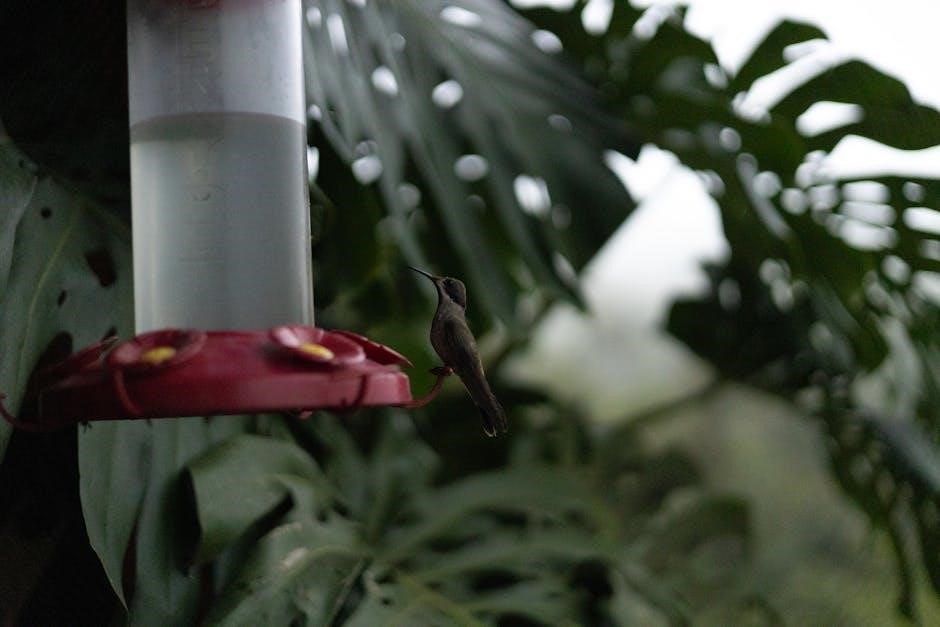
Low-cost DIY bird feeder projects are perfect for budget-conscious enthusiasts. Using affordable materials like disposable pie plates, gelatin, and seeds, you can create simple feeders. These projects are ideal for families or beginners, offering a fun and educational experience. Many plans require minimal tools and inexpensive supplies, making them accessible to everyone. With quick assembly and easy customization, these feeders provide an economical way to support birdlife while enjoying a creative activity. They’re great for teaching kids about nature and recycling in a hands-on way.
Free Plans and Resources
Free bird feeder plans and resources are widely available online, offering detailed designs and instructions. Many platforms provide downloadable PDF guides, complete with measurements, material lists, and step-by-step directions. These resources cater to all skill levels, from simple DIY projects to more complex designs. Users can access free plans for various feeder styles, including cedar wood and recycled material designs. Additionally, some websites offer video tutorials and interactive guides to enhance the building experience. These resources make it easy to start your project without additional costs, ensuring a fun and rewarding DIY journey for bird enthusiasts of all ages.
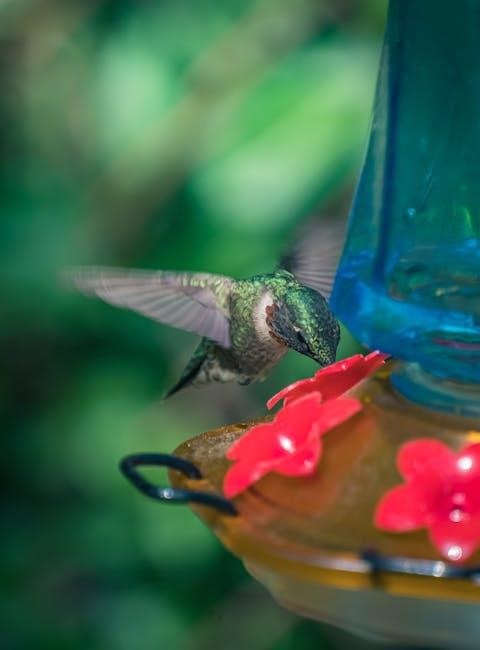
Troubleshooting Common Issues
Identify and resolve common problems like uneven assembly, loose parts, or pest infestations. Ensure proper sealing to prevent seed spoilage and regular cleaning for optimal performance.
Common Mistakes
When building bird feeders, common mistakes include incorrect measurements, improper material usage, and poor assembly techniques. Ensure all cuts are precise and angles are accurate. Avoid using nails instead of screws, as they can loosen over time. Failing to seal gaps properly can lead to water damage and rot. Additionally, placing the feeder in the wrong location or using the wrong type of seed can deter birds. Always follow the plan carefully and double-check each step before moving on to the next.
Repairing Damaged Feeders
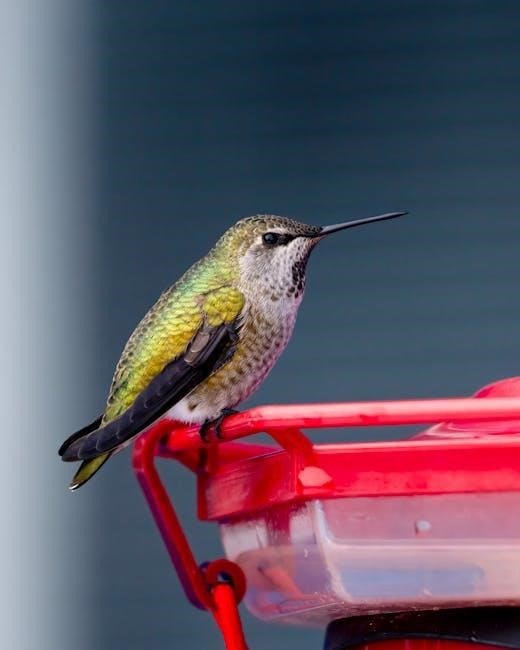
Repairing a damaged bird feeder involves assessing the damage and using appropriate materials. For wooden feeders, sand and repaint or seal cracks to prevent rot. Replace any loose or broken parts, such as perches or trays, using the original plans as a guide. Clean the feeder thoroughly before making repairs to ensure proper adhesion of glue or sealants. Reattach any detached components securely, and consider adding a protective finish to extend the feeder’s lifespan. Regular maintenance can prevent further damage and keep the feeder functional for years.
Improving Feeder Performance
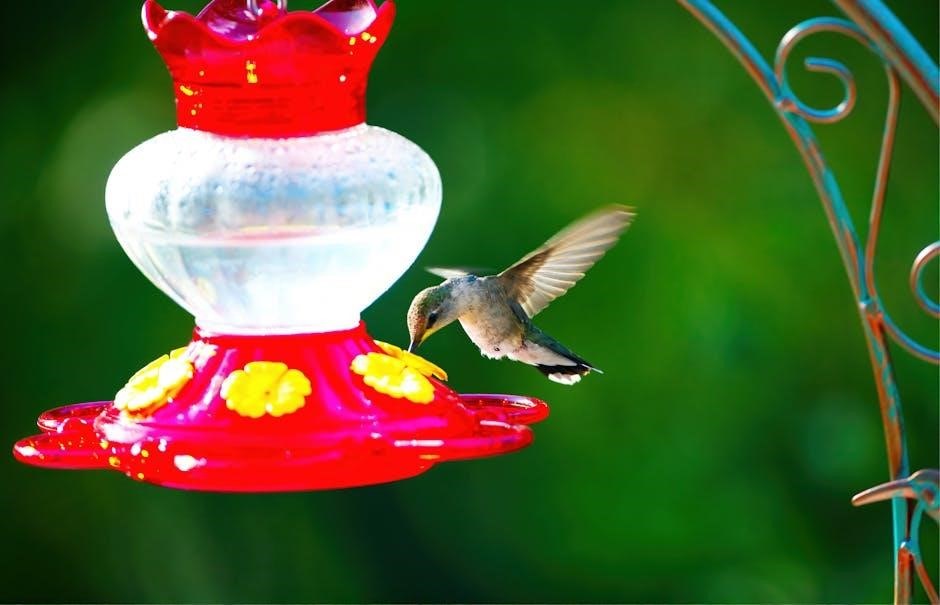
Enhance your bird feeder’s functionality by ensuring easy cleaning and proper seed flow. Regularly inspect and maintain the feeder to prevent mold and spoilage. Consider adding a roof or tray to protect seeds from rain and provide a comfortable feeding area. Use durable materials like cedar or recycled plastic for longevity. Position the feeder in a shaded spot to keep seeds fresh and attract more birds. These simple adjustments can significantly improve the performance and appeal of your DIY bird feeder.
Creating a bird-friendly environment with DIY bird feeders is easy and rewarding. Start your project today and enjoy the joy of birdwatching!
Final Thoughts on Bird Feeder Plans
Bird feeder plans PDFs offer a convenient and detailed guide for creating bird feeders at home. With step-by-step instructions, material lists, and design options, these plans make DIY projects accessible to everyone. Whether you’re using recycled materials or building from scratch, bird feeder plans provide the tools to create a functional and eco-friendly feeding station. They cater to all skill levels, ensuring that anyone can contribute to attracting birds to their garden while enjoying a fun and creative activity. Start building today and welcome birds to your yard!
Encouragement to Start Building
Building a bird feeder is a fun and rewarding project that brings joy to both you and the birds. With bird feeder plans PDFs, you can easily get started, even if you’re new to DIY projects. The sense of accomplishment from creating something with your own hands is unbeatable. Plus, it’s a great way to connect with nature and attract beautiful birds to your yard. So, gather your materials, follow the guide, and enjoy the process of creating a haven for your feathered friends!
Additional Resources
For more detailed guidance, explore free bird feeder plans PDFs available online. These resources often include step-by-step instructions, material lists, and diagrams; Many websites offer downloadable blueprints, while others provide video tutorials and expert tips. Platforms like Pinterest and YouTube showcase creative designs and DIY projects. Additionally, blogs and forums share user experiences, troubleshooting tips, and innovative ideas. Whether you’re a novice or an experienced builder, these resources can enhance your bird feeder project and inspire new creations for your backyard.
